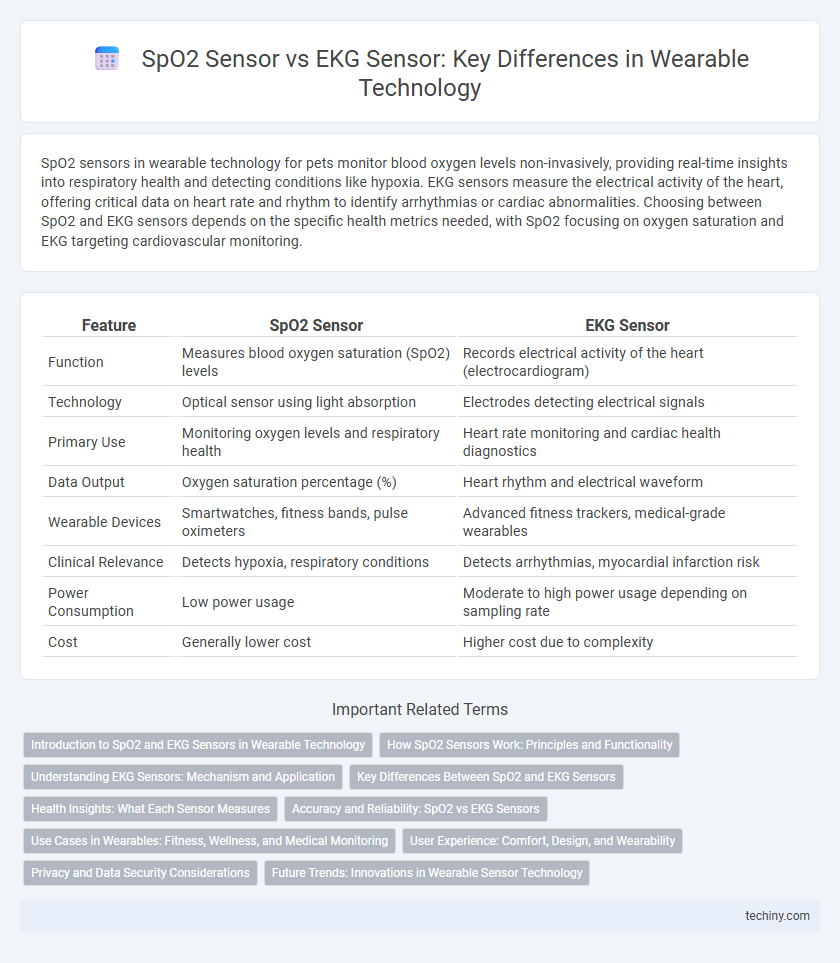SpO2 sensors in wearable technology for pets monitor blood oxygen levels non-invasively, providing real-time insights into respiratory health and detecting conditions like hypoxia. EKG sensors measure the electrical activity of the heart, offering critical data on heart rate and rhythm to identify arrhythmias or cardiac abnormalities. Choosing between SpO2 and EKG sensors depends on the specific health metrics needed, with SpO2 focusing on oxygen saturation and EKG targeting cardiovascular monitoring.
Table of Comparison
| Feature | SpO2 Sensor | EKG Sensor |
|---|---|---|
| Function | Measures blood oxygen saturation (SpO2) levels | Records electrical activity of the heart (electrocardiogram) |
| Technology | Optical sensor using light absorption | Electrodes detecting electrical signals |
| Primary Use | Monitoring oxygen levels and respiratory health | Heart rate monitoring and cardiac health diagnostics |
| Data Output | Oxygen saturation percentage (%) | Heart rhythm and electrical waveform |
| Wearable Devices | Smartwatches, fitness bands, pulse oximeters | Advanced fitness trackers, medical-grade wearables |
| Clinical Relevance | Detects hypoxia, respiratory conditions | Detects arrhythmias, myocardial infarction risk |
| Power Consumption | Low power usage | Moderate to high power usage depending on sampling rate |
| Cost | Generally lower cost | Higher cost due to complexity |
Introduction to SpO2 and EKG Sensors in Wearable Technology
SpO2 sensors in wearable technology measure blood oxygen saturation using photoplethysmography, providing critical data for monitoring respiratory and cardiovascular health. EKG sensors detect the electrical activity of the heart through electrodes, enabling precise tracking of heart rhythm and detecting arrhythmias. Both sensors enhance wearable devices' capabilities in continuous health monitoring and early detection of medical conditions.
How SpO2 Sensors Work: Principles and Functionality
SpO2 sensors operate based on photoplethysmography (PPG) by emitting red and infrared light through the skin to measure blood oxygen saturation levels. The sensor detects variations in light absorption caused by oxygenated and deoxygenated hemoglobin, enabling accurate, real-time monitoring of SpO2. Unlike EKG sensors that measure electrical heart activity, SpO2 sensors provide critical insights into respiratory and circulatory efficiency through non-invasive optical methods.
Understanding EKG Sensors: Mechanism and Application
EKG sensors detect electrical signals generated by the heart through surface electrodes, providing detailed insights into heart rate, rhythm, and cardiac abnormalities. These sensors measure the heart's electrical activity by capturing voltage fluctuations during cardiac cycles, enabling continuous real-time monitoring essential for diagnosing arrhythmias and myocardial infarctions. Integration of EKG sensors in wearable technology enhances cardiovascular health management by offering precise, non-invasive detection and data analysis for personalized medical interventions.
Key Differences Between SpO2 and EKG Sensors
SpO2 sensors measure blood oxygen saturation by detecting light absorption through pulse oximetry, providing insights into respiratory efficiency and detecting hypoxemia. EKG sensors capture the electrical activity of the heart through electrodes placed on the skin, enabling detailed monitoring of heart rate, rhythm, and cardiac abnormalities. While SpO2 sensors focus on oxygen levels in the blood, EKG sensors offer comprehensive cardiac electrical activity analysis, making each sensor crucial for distinct physiological monitoring in wearable technology.
Health Insights: What Each Sensor Measures
SpO2 sensors measure blood oxygen saturation levels, providing critical data on respiratory efficiency and early detection of conditions like hypoxemia. EKG sensors capture the electrical activity of the heart, enabling continuous monitoring of heart rhythms and identification of arrhythmias or cardiac anomalies. Together, these sensors offer comprehensive health insights by tracking both oxygen delivery and cardiac function in real time.
Accuracy and Reliability: SpO2 vs EKG Sensors
SpO2 sensors measure blood oxygen saturation by analyzing light absorption through the skin, offering quick and non-invasive readings with moderate accuracy affected by motion and skin tone. EKG sensors monitor the heart's electrical activity, providing high accuracy and reliable data for detecting arrhythmias and heart conditions, even during physical activity. While SpO2 sensors are ideal for general oxygen monitoring, EKG sensors deliver superior precision for cardiovascular health assessment in wearable technology.
Use Cases in Wearables: Fitness, Wellness, and Medical Monitoring
SpO2 sensors in wearables primarily monitor blood oxygen levels, supporting fitness activities by tracking oxygen saturation during exercise and enhancing wellness through sleep quality assessment. EKG sensors enable continuous heart rhythm monitoring, crucial for detecting arrhythmias and providing medical-grade cardiac data in real-time health management. Combining SpO2 and EKG sensors advances comprehensive health monitoring, facilitating early detection of conditions such as sleep apnea and cardiovascular diseases in wearable technology.
User Experience: Comfort, Design, and Wearability
SpO2 sensors in wearable technology are typically smaller and more lightweight, enhancing user comfort during prolonged use by minimizing skin irritation and pressure. EKG sensors often require additional electrodes and wiring, which can compromise sleek design and limit flexibility, affecting overall wearability. The compact and non-intrusive design of SpO2 sensors provides a more seamless user experience for continuous health monitoring.
Privacy and Data Security Considerations
SpO2 sensors primarily collect blood oxygen saturation levels, generating less detailed personal health data compared to EKG sensors, which record complex electrical heart activity and can reveal sensitive cardiac conditions. Data from EKG sensors often require stronger encryption protocols and stringent privacy measures due to the potential for misuse in diagnosing serious health issues. Both sensor types benefit from anonymization techniques and secure Bluetooth or Wi-Fi transmission standards to safeguard user information against unauthorized access.
Future Trends: Innovations in Wearable Sensor Technology
SpO2 sensors are evolving with enhanced accuracy and integration of AI algorithms for continuous blood oxygen monitoring, enabling early detection of respiratory conditions. EKG sensors are advancing toward multi-lead capabilities in compact designs, improving arrhythmia detection and real-time cardiac analysis in wearable devices. Future trends emphasize hybrid sensor systems combining SpO2 and EKG functionalities for comprehensive health monitoring in next-generation wearables.
SpO2 Sensor vs EKG Sensor Infographic

 techiny.com
techiny.com